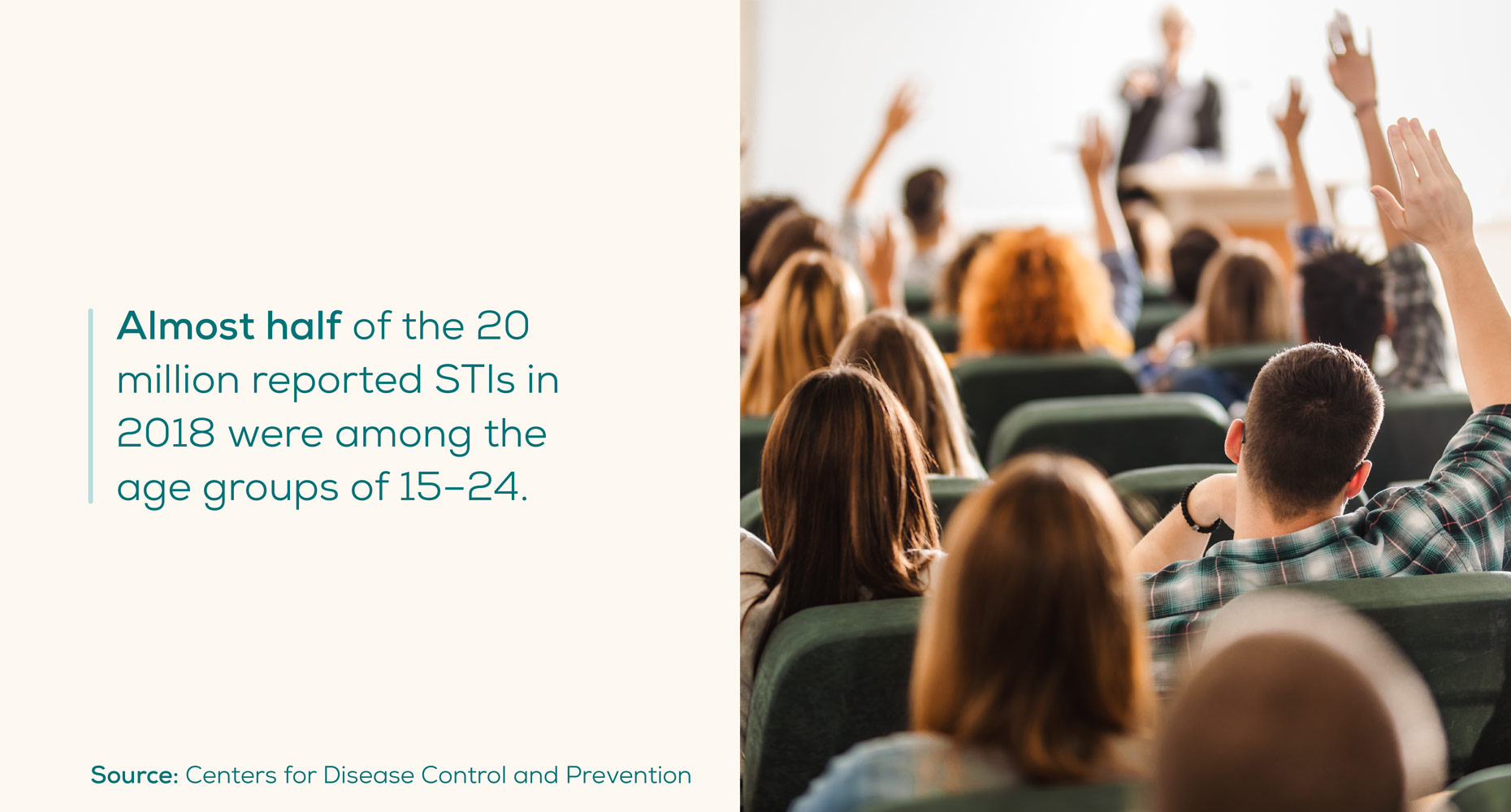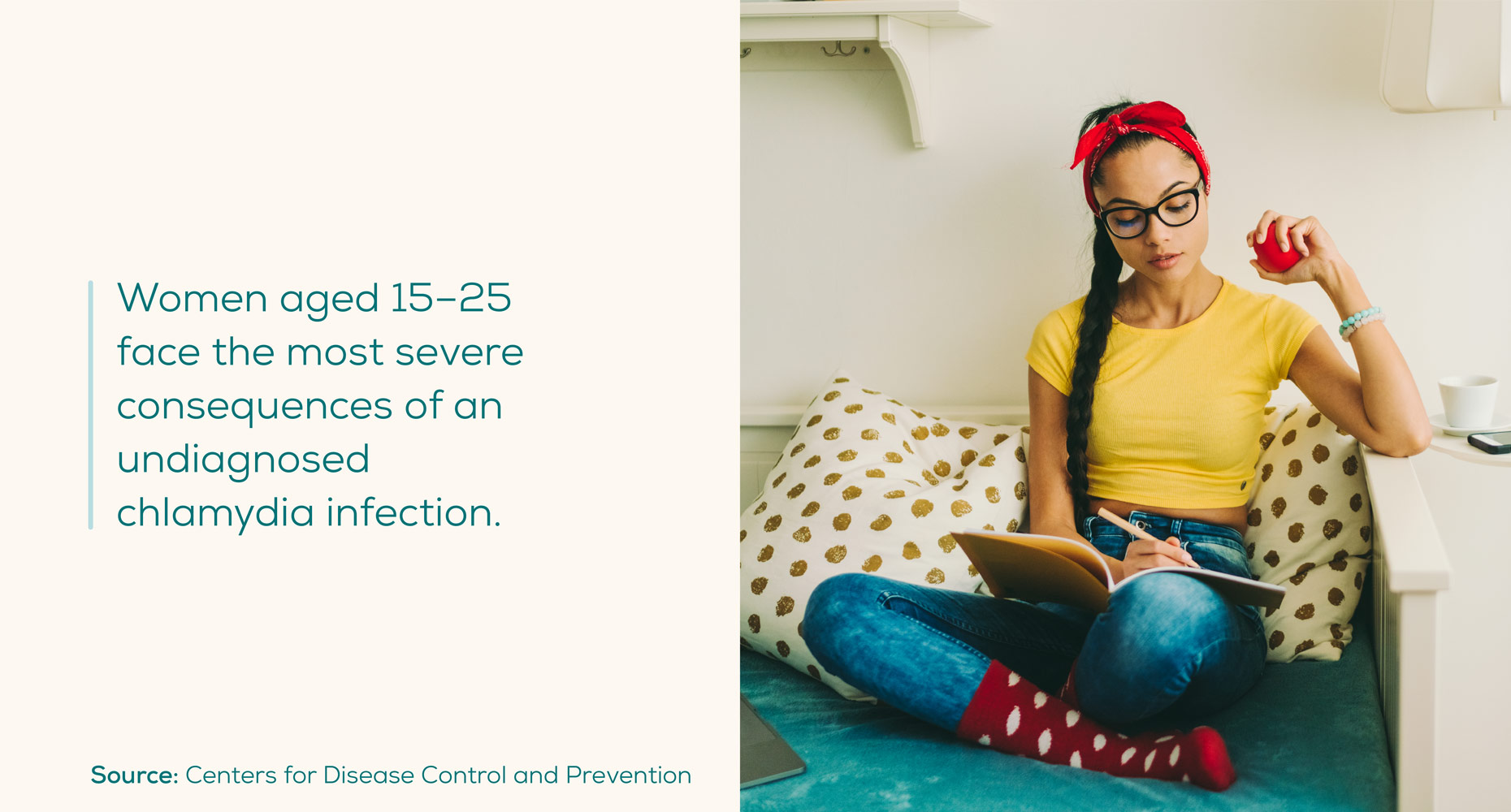
38 STD and STI statistics for college students: how to keep yourself healthy and safe
Published February 15, 2022.
For many, college is a time to embrace independence for the first time. Many students begin living on their own, sometimes in a brand-new place, which allows the freedom to explore their identities and who they want to be.
This exploration can often involve new sexual activity with new partners. In order to keep yourself protected and safe while having the freedom to explore, it’s important to know the numbers behind STD statistics for college students. Keeping yourself informed on the prevalence of sexually transmitted infections among 18–24-year-olds is one way to take control over your health and wellness and safety in your new collegiate chapter.
STIs (sexually transmitted infections) and STDs (sexually transmitted diseases) often refer to the same group of viruses and bacteria that are spread through sexual activity. An STD is the later phase of an STI, though not all STIs develop into STDs. Some infections can even present without symptoms, so the term STI is becoming more commonly used.
Don’t forget to check out the infographic on ways to advocate for yourself for the first time while in college.
STD and STI Rate Growth Among College Students
Rates of sexually transmitted infections in the U.S. have hit a record high for the sixth year in a row, with over 2.5 million cases of the three most prevalent STDs (chlamydia, gonhorrea, and syphilis) reported.
Young people aged 15–24 make up 61% and 42% of chlamydia and gonorrhea cases, respectively; emphasizing the importance of knowing your statistics when it comes to the most common STDs among college students.
- Almost half of the 20 million reported STIs in 2018 were among the age groups of 15–24 (Centers for Disease Control and Prevention).
- Approximately 21 percent of known HIV cases in 2018 were reported by people aged 13–24 (Centers for Disease Control and Prevention).
- The highest numbers of STIs are reported among college-aged students (Microbiology & Infectious Diseases).
- Some of the most prevalent STIs among college students are HIV/AIDS, herpes, chlamydia, and gonorrhea (Centers for Disease Control and Prevention).
- There were 2.5 million reported cases of chlamydia, gonorrhea, and syphilis in 2019 (Centers for Disease Control and Prevention).
- One in five of all new HIV diagnoses are reported by people aged 13–24 (Centers for Disease Control and Prevention).
- People aged 15–24 made up 61 percent of chlamydia cases in 2019 (Centers for Disease Control and Prevention).
- The same age group accounted for 42 percent of gonorrhea cases in 2019 (Centers for Disease Control and Prevention).
- Reports of gonorrhea in 2019 were highest for adults aged 20–24, with over 162,000 cases (Centers for Disease Control and Prevention).
- The most prevalent STI among college-aged students is HPV (Microbiology & Infectious Diseases).

STD Rates Among College Students by Biological Sex and Sexuality
Below are breakdowns of STD statistics among college-aged cishet (cisgender and heterosexual) and LGBTQ+ students.
STI Statistics Among College-Aged Men
- Men aged 20–24 accounted for over 83,000 reported cases of gonorrhea in 2019 (Centers for Disease Control and Prevention).
- Men in the same age group had the highest chlamydia rates of all men in 2019, at 1,871 cases (Centers for Disease Control and Prevention).
- 87 percent of HIV diagnoses in 2019 were men, many of whom are gay or bisexual (Centers for Disease Control and Prevention).
- Gay and bisexual men made up nearly 50 percent of all primary and secondary syphilis diagnoses in 2019 (Centers for Disease Control and Prevention).
- Over 58% of reported gonorrhea infections in 2019 were among men. (Centers for Disease Control and Prevention).
- Gonorrhea rates among gay and bisexual men in 2019 were 42 times that of heterosexual men, in certain geographical regions (Centers for Disease Control and Prevention).
- Gay, bisexual, and other men who reported having sex with men accounted for 69 percent of new HIV diagnoses, as well as 86 percent of total diagnoses among men in 2019 (Centers for Disease Control and Prevention).
STI Statistics Among College-Aged Women
- Studies have established that generally, women have a higher biological risk for contracting STDs than men (Microbiology & Infectious Diseases).
- Women aged 15–25 face the most severe consequences of an undiagnosed chlamydia infection, such as infertility (Centers for Disease Control and Prevention).
- 12 percent of reported HIV cases in 2018 among 13–24-year-olds were women (Centers for Disease Control and Prevention).
- It’s estimated that 1 in 20 sexually active women between the ages of 14–24 have chlamydia (American Sexual Health Association).
- 18-year-old women accounted for over 102,000 reported cases of chlamydia in 2019 (Centers for Disease Control and Prevention).
 23. Women aged 15–19 had the second-highest reported rates of chlamydia in 2019, at 3,333 cases (Centers for Disease Control and Prevention).
24. Over 64% of reported chlamydia infections of all ages were among women in 2019 (Centers for Disease Control and Prevention).
25. Chlamydia was reported by more 19-year-old women in 2019 than any other age group, with 116,097 cases (Centers for Disease Control and Prevention).
26. The rates of gonorrhea among women aged 15–24 increased by 3 percent from 2018 to 2019 (Centers for Disease Control and Prevention).
27. Gonorrhea was reported by more 19-year-old women than any other age group in 2019, with 18,904 cases (Centers for Disease Control and Prevention).
23. Women aged 15–19 had the second-highest reported rates of chlamydia in 2019, at 3,333 cases (Centers for Disease Control and Prevention).
24. Over 64% of reported chlamydia infections of all ages were among women in 2019 (Centers for Disease Control and Prevention).
25. Chlamydia was reported by more 19-year-old women in 2019 than any other age group, with 116,097 cases (Centers for Disease Control and Prevention).
26. The rates of gonorrhea among women aged 15–24 increased by 3 percent from 2018 to 2019 (Centers for Disease Control and Prevention).
27. Gonorrhea was reported by more 19-year-old women than any other age group in 2019, with 18,904 cases (Centers for Disease Control and Prevention).
Sexual Behavior Statistics Among College-Aged Students
While abstinence is the number one way to protect yourself from STDs, there are a variety of safe sex practices such as wearing a condom, and regular testing that can help you experiment with sex safely as a college student. Read on to learn more about sexual health behavior statistics among college-aged students. 28. 66 percent of college students reported having sex within the past year (Microbiology & Infectious Diseases). 29. Only 7 percent of male college students reported STI testing in a 12-month time period, compared to 20 percent of female college students (Journal of the American Sexually Transmitted Diseases Association). 30. A 2019 national survey found that 40 percent of college males and 55 percent of college females received and completed the recommended doses of HPV vaccination (Microbiology & Infectious Diseases). 31. On average, men have 4.98 sexual partners in college, while women have 4.90 (College Stats). 32. By the time they finish college, men have an average of 14 lifetime sexual partners, while women have an average of 12 (College Stats). 33. 62 percent of college students in a national survey reported always or usually wearing a condom (Microbiology & Infectious Diseases). 34. Male college students are more likely than female students to have used a condom during their last sexual experience (Papers & Publications: Interdisciplinary Journal of Undergraduate Research). 35. 15 percent of college students in a national survey reported never using a condom during sex (College Stats). 36. 75 percent of college men reported only wearing a condom when their partner asks (College Stats). 37. More than 88 percent of students in a 2018 survey said they would use self-collection STD test kits they could use in the privacy of their homes (Journal of American College Health). 38. The most popular form of birth control among college students is the birth control pill, with the male condom being the second most popular (Statista).
You should feel confident about the decisions you make on your own as a college student, including those about your sexual health. Luckily, we’ve got your back. Together, we can advocate for sexual health with easy access to affordable STI testing and prescriptions if you need them from Everlywell. If you do find yourself in need of an STI test, we’ve got you covered with any of our sexual health tests for both men and women.
Infographic
